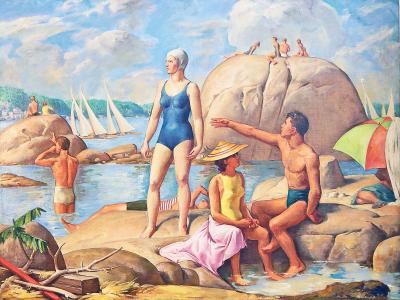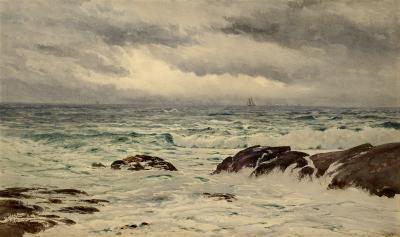Cape and Island Vistas: Contrasting New England Art Colonies
 |
by James F. O’Gorman
 |
round the turn of the twentieth century many American artists began to gather seasonally into informal “colonies” dotted across the country from California to the Northeast. Peterborough in New Hampshire, Provincetown in Massachusetts, Old Lyme and Cos Cob in Connecticut, and Ogunquit in Maine, many of them coastal sites, were among the most important eastern areas that hosted visiting artists. The 2021-2022 exhibition, Cape Ann and Monhegan Island Vistas: Contrasted New England Art Colonies, organized by the Monhegan Museum of Art & History in conjunction with the Cape Ann Museum, gathered works executed by some of the many landscape artists who worked both on Monhegan Island, some ten miles off the coast of Maine, and at seaside Cape Ann in Massachusetts. The two areas are otherwise different in every way except for the attractiveness of their eye-catching marine vistas, the historic importance of the fishing industry, and to this day the presence of artists, both professional and amateur, behind nearly every other rock, tree, or building. Works by the selected artists who visited both areas record the differences between the two locales.
 | |
Fig. 1: Eric Hudson (1864–1932), Under Dark Sky, n.d. Oil on canvas, 24¼ x 20¼ inches. Monhegan Museum of Art & History; Gift of James F. O’Gorman and Jean Baer O’Gorman. |
Monhegan Island is a tiny outcropping, about a mile-and-a-half long and half-a-mile wide, an hour’s ride by mail boat off the Maine coast. The village consists of scattered, carpenter-shaped, wood-framed single houses punctuated by a few hotels and boarding houses, a church, and a one-room schoolhouse, all connected by rough gravel roads traversed by foot, golf carts, or pick-up trucks. The Monhegan Museum of Art & History, located in the historic lighthouse complex, overlooks the village from its perch atop Lighthouse Hill. The year-round resident population has never risen above two hundred, and these days hovers around fifty. Small lobster boats dot its tiny harbor. Dramatic Cathedral Woods is the chief interior attraction. On the east, sheer cliffs rise from the sea foam and dramatically crashing waves to heights unmatched anywhere along the coast.
Cape Ann is markedly different. The area embraces two developed urban centers, Gloucester and Rockport. Gloucester, with a population of about 30,000, has many picturesque spires, architect-designed buildings, such as the bristling brick City Hall, and an industrially active waterfront, with a fish processing plant, and a harbor that bustles with the coming and going of seafaring boats. Its cultural center is the Cape Ann Museum. A short four miles away is the village of Rockport, once noted for its stone quarries, vestiges of which, now swimming holes, dot the largely wooded landscape. The Rockport Art Association and Museum is the center of artistic life.
 |
Fig. 2: Eric Hudson (1864–1932), Boats, Rockport, n.d. Oil on canvas, 20 x 24 inches. Rockport Art Association & Museum Permanent Collection. |
 |
Fig. 3: Jacqueline Hudson (1910-2001), Church Fair, Main St., Rockport, n.d. Watercolor and gouache on paper, 20¾ x 29¼ inches. Rockport Art Association & Museum Permanent Collection. |
 |
Fig. 4: Jacqueline Hudson (1910–2001), Storm in Monhegan Harbor, n.d. Watercolor and gouache on paper, 14¾ x 22¼ inches. Monhegan Museum of Art & History; Gift of Libbie Twining, 1994. |
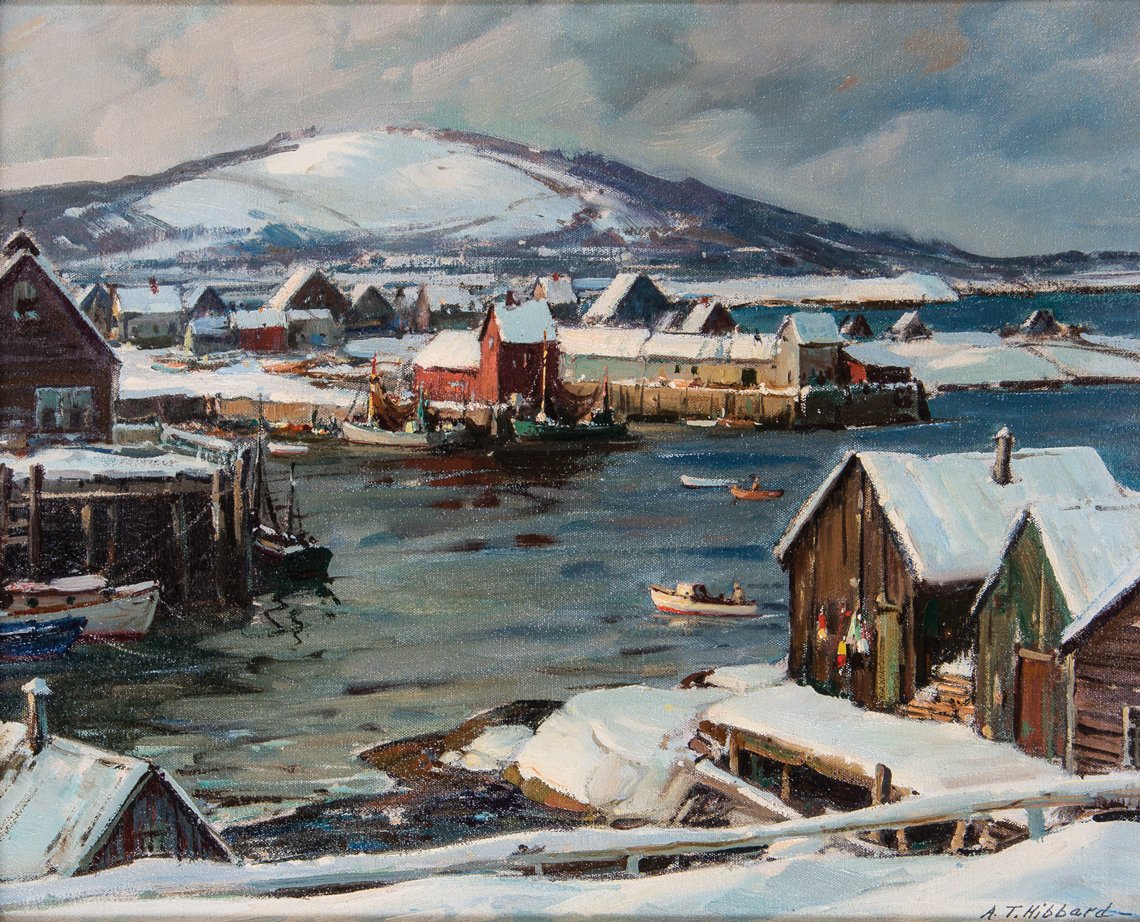 |
Fig. 5: Aldro T. Hibbard (1886–1972), Motif #1, Rockport Harbor, n.d. Oil on canvasboard, 17 x 21 inches. The James Collection. Promised gift of Janet and William Ellery James to the Cape Ann Museum. |
 | |
Fig. 6: Donald Allen Mosher (1945–2014), Monhegan Headlands, n.d. Oil on canvas, 30 x 20 inches. Private Collection. |
Monhegan Island and Cape Ann, one hundred sea miles apart, have attracted many of the same artists during the course of more than a century. Painters, and some printmakers and sculptors, began to appear after the Civil War. A group of New Yorkers led by Robert Henri first went to Monhegan in 1903. Over the next decade that number included Sunday painters as well as famous ones, such as George Bellows, Randall Davey, Rockwell Kent, and Leon Kroll. The years that followed, the late teens and the nineteen-twenties, saw the arrival of Edward Hopper, James Fitzgerald, Margaret Patterson, and others. At the same time, the more easily reached Cape Ann began to host its own distinguished list of artists, including William Morris Hunt, Winslow Homer, Frank Duveneck, Maurice Prendergast, John Sloan, Stuart Davis, Theresa Bernstein, Edward Hopper, and on and on. Many more artists who established these sites in American cultural history are less familiar to the general public. The exhibition is weighted toward their work as more representative of the art life of the communities. In every case, the artists worked at both sites, often revealing in pairs of works the differences between the Cape and the Island.
Among the first artists to arrive on Monhegan was Eric Hudson (1864–1932), a photographer as well as painter who sought out locations along the Maine coast that offered vistas of marine activity. His Under Dark Sky (Fig. 1) could just as well have been inspired by the sight of a sailboat and dory in Gloucester harbor just as the sailing craft in his Boats, Rockport (Fig. 2) could have been moored at Monhegan. Wherever he worked Hudson painted and photographed the architecture of boats that, in the words of one critic, “ride the waves . . . like the heavily built craft that they are.”
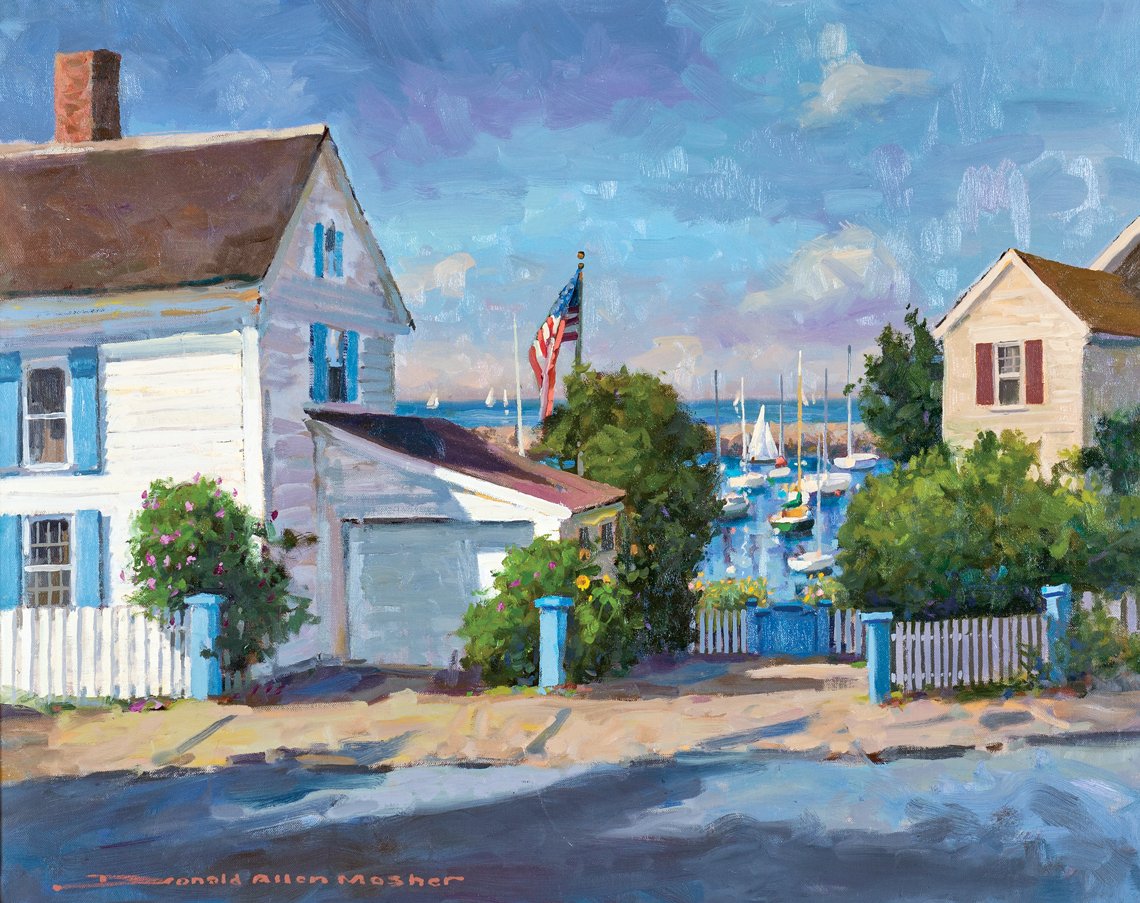 |
Fig. 7: Donald Allen Mosher (1945–2014), Harbor View, 2013. Oil on canvas, 31½ x 38 inches. Courtesy of the Mosher Estate. |
 |
Fig. 8: Edward Henry Potthast (1857–1927), Crow’s Nest, Monhegan, 1920s. Watercolor with gouache, 15¾ x 19½ inches. Private Collection. |
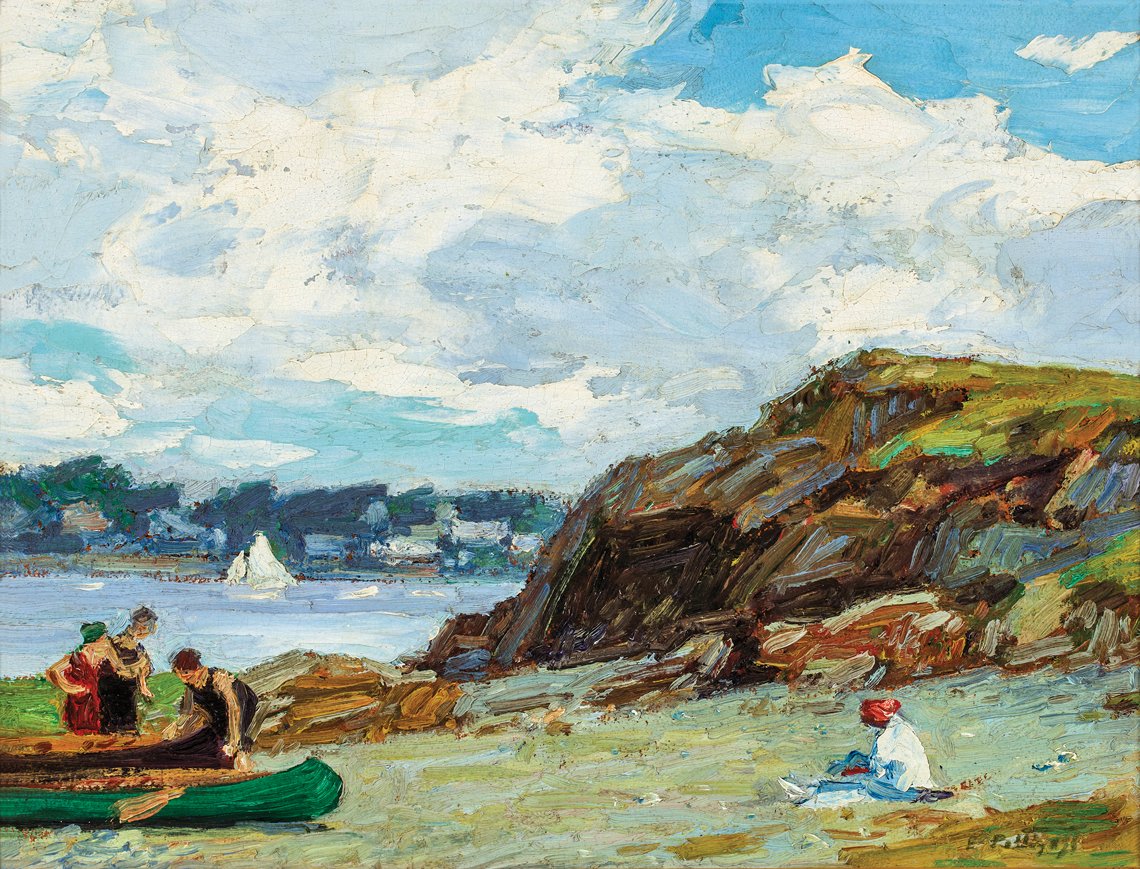 |
Fig. 9: Edward Henry Potthast (1857–1927), Breezy Day, 1920s. Oil on board, 12 x 16 inches. The James Collection; Promised gift of Janet and William Ellery James to the Cape Ann Museum. |
 |
Fig. 10: Paul Strisik (1918-1998), Evening Tide, Good Harbor Beach, Gloucester, 1974. Oil on linen canvas, 20 x 30 inches. Collection of Nancy Strisik. |
 | |
Fig. 11: Leon Kroll (1884-1974), Eden Road, Rockport, 1961. Oil on board, 36¼ x 27¼ inches. Collection of the Cape Ann Museum, Gloucester, MA; Gift of Marie Claude Rose, 1988. |
Women have always been well represented in these colonies, Eric Hudson’s daughter among them. Jacqueline (Jackie) Hudson (1910–2001), landscape painter and printmaker, spent much of her life on Monhegan. Her two works in the show diverge sharply in content. Her energetic Church Fair, Main Street, Rockport (Fig. 3) is a colorful, optimistic view of Cape people at play. Her watercolor, Storm in Monhegan Harbor (Fig. 4), is dramatically different. The colors are menacingly dreary, and what looks like an eastern-rig dragger is about to be swirled into a vortex or dashed upon Smutty Nose. On the right, the gantry or “gallows frame,” beneath which visitors, notably absent here, first step onto the island, is stark against the gloom.
European-trained Boston School artist and Cape Ann resident, Aldro T. Hibbard’s (1886–1972) pair of scenes record the difference between wintery Rockport harbor architecture, in this case, a shed known to artists and public alike as Motif No. 1 (Fig. 5) and a view of crashing surf at Monhegan. Among other artists to represent the harbor were Bernard Corey (1914–2000), who waited until the snows of winter to record his version of a Rockport harbor shed, and John Chetcuti (1900–1976), who chose to isolate the harbor motif at the end of its own pier.
 |
Fig. 12: Paul Strisik (1918–1998), Monhegan Pier, 1959. Oil on canvas, 24 x 30 inches. Monhegan Museum of Art & History; Gift of Nancy Strisik, 2002. |
 |
Fig. 13: Theresa Bernstein (1890–2002), The Island Inn and Wharf, n.d. Oil on canvas, 12 x 16 inches. Private Collection. |
The tiny boat in the upper right-hand corner of Donald Allen Mosher’s (1945–2014) vertical Monhegan Headlands (Fig. 6), a topographical vista from Black Head to White Head, gives scale to a dramatic long-range view of the island’s “backside.” On Monhegan, he recorded such rugged forms of geology, while on Cape Ann, his eye caught more sedate scenes in Gloucester, such as his Harbor View (Fig. 7), in which sailboats in the harbor are framed by prosaic domestic architecture. Edward Henry Potthast (1857–1927) depicted a special geological formation on the Island. His watercolor Crow’s Nest, Monhegan (Fig. 8) shows an out-cropping near the southern tip known as the Crow’s Nest. While summery Breezy Day (Fig. 9) is a depiction of the recreational waterside scene for which he is best known.
Intimate scenes of Cape Ann such as Leon Kroll’s (1884–1974) Eden Road, Rockport, (1961) (Fig. 11) and Paul Strisik’s (1918–1998) Evening Tide, Good Harbor Beach, Gloucester (Fig. 10), capture a tranquil aspect of the local experience. Eden Road, once a local pathway, is now a tourists’ auto route that still runs around the forested interior and edges the land that overlooks the twin lighthouses on Thacher Island; while Good Harbor Beach is a local stretch of sand favored by locals and visitors alike. On Monhegan in 1959, the Strisik found a livelier scene perched above the water in Monhegan Pier (Fig. 12). Lobster traps, fishing boats, and dory suggest a vibrant local economy.
 |
Fig. 14: Emile Gruppé (1896–1978), Gloucester Harbor, n.d. Oil on canvas, 20 x 24 inches. Rockport Art Association & Museum Permanent Collection. |
 |
Fig. 15: Emile Gruppé (1896–1978), The Monhegan Harbor, n.d. Watercolor on paper, 14 x 21¾ inches. Private Collection. |
 |
Fig. 16: Charles Movalli (1945–2016), Fish Houses, Monhegan, ca. 2010. Acrylic on linen, 36 x 36 inches. Collection of Dale Ratcliff Movalli. |
 |
Fig. 17: Rudolph Colao (1927–2014), Monhegan Fish Shack, m.d. Oil on masonite, 12 x 16 inches. Courtesy of the R. Colao Estate. |
On a trip to the island, Theresa Bernstein (1890–2002), a long-time summer resident of Gloucester, climbed Horn’s Hill to record the topography in Island Inn and Wharf (Fig. 13), a small but sweeping scene that includes the prominent hostelry, some of the oldest buildings in the village, the wharf with its gantry, Manana (the small island that forms the west side of the harbor), and the sea in the distance. Little has changed since Bernstein put down her brush. Emile A. Gruppé’s (1896–1978) oil painting of idle sailing craft in Gloucester Harbor, (Fig. 14), with the tower of City Hall rising beyond a dense mass of buildings, is a firm rendering of a substantial urban scene. On the Island he used a lighter touch in painting the much smaller and quieter Monhegan Harbor, (Fig. 15), with its wooden lobster traps and small fishing fleet. For this he switched from oil to watercolor, a change that suggests he agreed with Marshall McLuhan that “the medium is the message.” Some artists drilled down to the details of daily life. Charles Movalli (1945–2016) offered an image of battered wooden sheds and colorful lobster buoys emblematic of the time-worn Monhegan Harbor (Fig. 16). While in Monhegan Fish Shack (Fig. 17), Rudy Colao (1927–2014) visually inventoried the contents of a harborside fish house, including lobstermen’s boxes, buckets, barrels, ropes, and foul weather slickers.
The paintings in the exhibit provided only a glimpse of the works inspired by these two locations over the past dozen or more decades. They are, no doubt but a prologue to continued creativity in future years.
Cape Ann and Monhegan Island Vistas: Contrasted New England Art Colonies was on view at the Monhegan Museum of Art & History, Monhegan, Maine, July 1–September 30, 2021, and the Cape Ann Museum, Gloucester, Massachusetts, October 30, 2021–February 13, 2022. An illustrated 64-page catalogue, with contributions by James F. O’Gorman, Martha Oaks, Jennifer G. Pye, and Oliver Barker, accompanied the exhibition.
James F. O’Gorman, guest curator of the exhibition, was the Grace Slack McNeil Professor Emeritus of the History of American Art at Wellesley College.
















